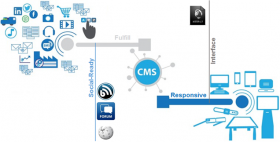
The term “Web 2.0”refers to evolved web techniques such as provide a better interaction between user and site.
This should be performed by the means of a CMS (Content Management System). It allows for websites based
on contents/comments paradigm.
Web 2.0 Architecture
The CMS is an infrastructural layer, offering the following advantages:
· Interface: the user choose the information (text, images, videos) to display, interacting with the website,
according to specific actions (e.g. click, sting insertion).
· Protocol: it acts like a buffer, uncoupling the information from the way these are displayed. This allow
for a more dynamic content uploads and modifications
· Service: it organize the content, structuring the information along the web interface
According to [1], only 38,6% of Web Sites make use of a CMS infrastructure (that is, 61.4% are more than static
website).
The information are no more static, these are collected, elaborated and presented depending on user input. The
following actions are performed orderly:
· retrieving input (link follow, form fill)
· translating input as punctual queries to perform interrogation
· accessing data set (DB), extracting the data
· calculating information to show (query results)
· displaying information to user, usually, in a user-dependent way (HTML resources)
HTTP and HTML are used as interface, merely. The Web 2.0 requires intelligence, a proper set of instruction
to react to user input (named Web Application). Moreover,
Thus, there are 3 main components in CMS-ready Web Infrastructure:
1. Web Server (the interface)
2. Web Application (the logic)
3. DB (the data set)
CMS: Logical Schema
CMS Functionality: Building and Updating Web-Site dynamically, without:
· HTML programming
· Server-side Language (PHP, Java, .Net) Programming
· DB designing and deploying
Moreover, the CMS allows dealing with today issues (both technical and social):
1. Responsiveness: different display (PC, SmartPhone, TouchScreen, etc) and new technologies (wearable
technologies, Internet of Things)
2. Social-Ready: user interaction (blog, forum, wiki, etc)
3. Fulfillness: augmented content types (docs, photos, images, video, audio, presentation, messages, etc)
By the means of only one interface: HTTP (1.1), uncoupling interface, aspect and content. The picture
depicts the CMS addressing its tasks
However, CMS is another application on top of previous HTTP-ready environment. It introduces (for sure) new vulnerabilities and threats. CMS Security should be addressed.

Comments
How to Secure the Web 2.0
How to Secure the Web 2.0 environment, since it needs CMS application to run